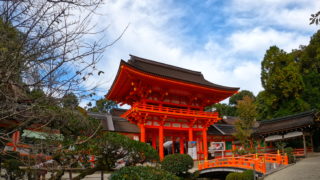

History of Ryoanji Temple 【龍安寺の歴史】
龍安寺公式ホームページ
http://www.ryoanji.jp/top.html

Daiunzan Ryoanji is a temple of the Rinzai sect Myoshinji faction.
This Zen temple was built in 1450 during the Muromachi period.
It was burnt down by the Onin War, but was rebuilt in 1499
Around this time, it seems that a “rock garden” was also built.
It burned again in 1797. It was soon rebuilt.
In 1975, Queen Elizabeth of England visited the rock garden.
She praised Queen Elizabeth for the beauty of the rock garden. And the rock garden has become known worldwide.

It was registered as a World Cultural Heritage Site in 1994.
There are many mysteries in the rock garden.
Who made it?
What is the theme of the idea?
Why is that composition?
It has been studied for a long time, but has not been identified.
The stone garden is a symbol of the era when Zen culture flourished.
Autumn leaves spread when you pass through the Sanmon Gate.
龍安寺:りょうあんじ
大雲山龍安寺
臨済宗妙心寺派(みょうしんじ)
1450年 室町時代に創建された禅寺です。
応仁の乱で焼失しましたが、1499年に再建しました。
このときに石庭も築造されたといわれています。
1797年火災により焼失しました。その後、再興されています。
1975年 英国エリザベス女王が訪問し石庭を拝観しました。
その際に、石庭の美しさを絶賛し、このロックガーデンは世界的に知られることとなりました。
1994年 世界文化遺産に認定されました。
石庭は謎が多く、
誰が作ったのか
何をテーマに作ったのか
なぜこのような構図になったのか
長い間、研究されていますが、多くの説があるものの特定されていません。
石庭は禅文化が盛んだった時代の象徴です。
三門をくぐると紅葉が広がります。
Kyoyochi Pond 【鏡容池】

Water lilies are in full bloom from May to September.
Around Kyoyochi Pond, you can feel the four seasons of Kyoto.
鏡容池(きょうようち) 5月から9月までは睡蓮の花が見頃です。
鏡容池の周辺は京都の四季を楽しむことができます。
Hojo Garden (Stone Garden) 【方丈庭園(石庭)】

Fifteen stones are lined up on a white sand beach 25m east-west and 10m north-south.
No matter where you look at the garden, you can’t see all the stones at once. Advanced gimmicks are applied.
The oil mud wall, which is a mixture of soil and rapeseed oil, has a long-lasting taste.
There is a picture of bran behind the Hojo Garden, so please see the picture of the dragon and Mt. Kongozan.
方丈庭園(石庭)
東西25m南北10m 白砂に15個の石が並んでいます。
どこから見ても一度に全ての石を見ることができません。高度な仕掛けが施されています。
菜種油を混ぜた土で作られた油土塀も長い年月により、大変趣のある色合いになっています。
その後ろには、襖絵が広がっていますので、龍や金剛山をぜひ御覧ください。
Tsukubai (a hand water bowl in the garden) 【蹲(つくばい)】

Tsukubai is engraved with “Ware tada taruo shiru (learn only to be satisfied)”.
Interpretations vary from person to person.
This Tsukubai is very valuable and is one of the reasons to visit Ryoanji Temple.
蹲 (縁側近くの庭に備えてある手水鉢のこと)
蹲には、「吾唯足知(われただたるをしる)」と刻まれています。
This Tsukubai has a deep inscription, “I learn only to be contented.”
「不満に思わず、何事にも満足する心をもつ。」解釈は、人それぞれです。
この蹲を見るために、龍安寺を訪れる人がいるほど、価値のあるものです。



















コメント